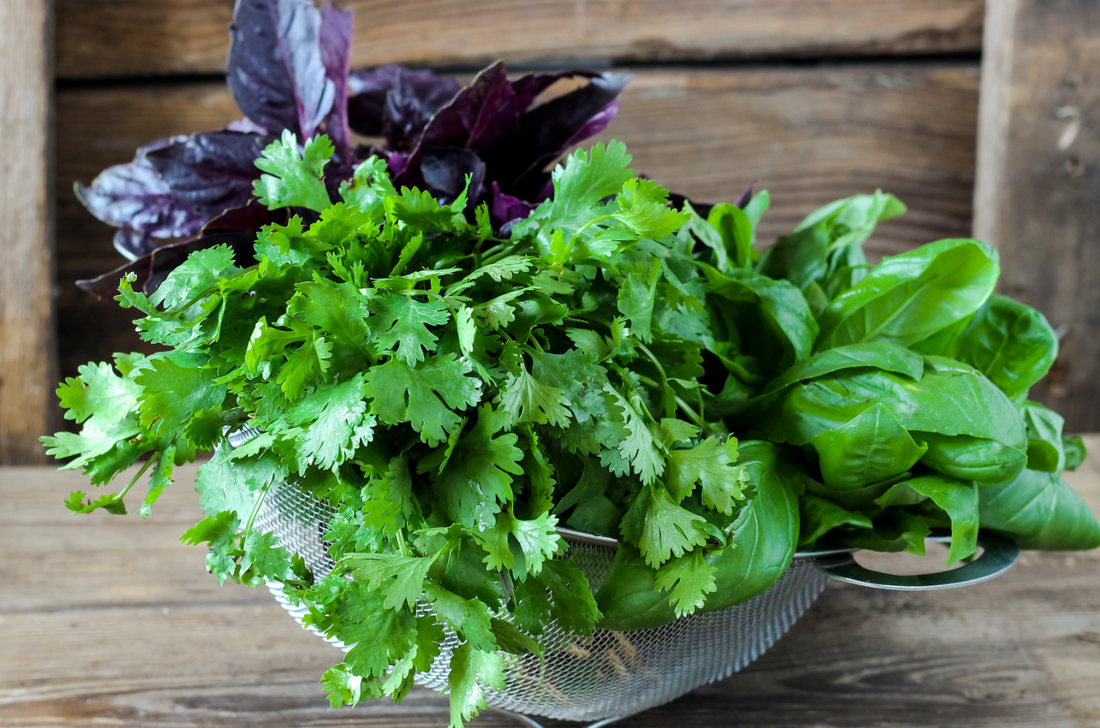Basil and cilantro are two culinary herbs that often grace kitchens and recipes around the world, yet they possess distinct characteristics. Basil is widely recognized for its large, curved leaves and a sweet, delicate flavor that enhances Italian and Mediterranean dishes.
Renowned for its compatibility with ingredients like tomatoes, garlic, and mozzarella, it's a staple in pestos, pasta, and even on top of pizzas. The versatility of basil allows it to be a flavorful addition to many dishes without overpowering other tastes.

Cilantro, meanwhile, brings a bold, somewhat divisive flavor profile to the table. Its citrusy and earthy tones are integral to the culinary traditions of Mexican, Indian, and Thai cuisines.
The herb's unique taste is a key element in foods ranging from salsas and guacamoles to curries and soups. Unlike basil, cilantro is known for its stronger flavor and is used with caution to ensure it harmonizes well with other ingredients in a dish.
While these herbs are both celebrated for their flavor and freshness, their different appearances, tastes, and culinary applications mean they are not typically interchangeable.
Cooks often select these herbs carefully based on the requirements of their recipes, paying attention to the distinctive contribution each makes to the final dish.
Botanical Classification
Both basil and cilantro are popular herbs used in a variety of cuisines, but they differ greatly in their botanical classification.
Basil Taxonomy
- Scientific Name: Ocimum basilicum
- Family: Lamiaceae (Mint family)
-
Characteristics:
- Basil leaves are generally broad, silky, and bright green.
- The plant reaches up to about 30 inches in height and blooms in late summer.
- Its family includes other herbs like mint and rosemary.
Cilantro Taxonomy
- Scientific Name: Coriandrum sativum
- Family: Apiaceae (Carrot or Parsley family)
-
Characteristics:
- Cilantro leaves are delicate with a distinct, serrated shape.
- The plant is shorter, reaching up to roughly 18 inches.
- Cilantro's family also contains parsley, carrots, and celery.
Culinary Uses
Basil and cilantro each bring distinctive flavors that enhance a variety of dishes across diverse culinary traditions. These herbs are not interchangeable due to their unique taste profiles and the cultural contexts in which they are used.
Basil in Cuisine
Basil, with its sweet and slightly peppery flavor, is a staple in Italian cooking. It pairs exceptionally well with tomatoes and is a key ingredient in pesto. Dishes like Margherita pizza and Caprese salad rely on the fresh taste of basil to balance and complement the flavors of mozzarella and tomatoes.
-
Common Basil Pairings:
- Tomatoes
- Mozzarella
- Olive oil
- Garlic
- Balsamic vinegar
Cilantro in Cuisine
Cilantro, known for its bold, citrusy, and sometimes divisive flavor, is essential in Mexican and Asian cuisines. It is often used fresh and added towards the end of the cooking process or as a garnish. Cilantro is a key component in salsas, and it brightens dishes like tacos, curries, and pho.
-
Frequent Cilantro Uses:
- Salsas and chutneys
- Marinades for meats
- Toppings for soups and noodles
- Salad dressings
By understanding the culinary contexts in which basil and cilantro excel, chefs and home cooks can better decide which herb will suit their specific dish.
Flavor Profiles
When exploring the aromatic herbs basil and cilantro, their distinct taste signatures are paramount. They can either be used to complement or to contrast flavors in culinary creations.
Tasting Basil
Basil presents a variety of taste nuances, predominantly characterized by its sweet and herbal qualities. Often, it bears distinctive notes of clove and licorice, sometimes accompanied by a mild peppery background. Certain species may also exhibit hints of citrus or cinnamon, enriching its complexity.
Tasting Cilantro
Cilantro, on the other hand, offers a bold and citrusy flavor profile that can be quite polarizing. Its leaves, unlike basil, can sustain long cooking periods without significant flavor loss. Coriander seeds, the spice form of cilantro, deliver a warm, nutty, and spicy taste, quite distinct from the fresh leaves themselves.
Growing Conditions
In the realm of home gardening, basil and cilantro are favored herbs, but their growing conditions differ significantly, affecting their care and yield.
Cultivating Basil
Basil thrives in warm temperatures, ideally between 70-85°F (21-29°C). It requires a sunny spot, with at least six hours of sunlight daily, and prefers well-drained, fertile soil. Overcrowding should be avoided by spacing plants 12 to 18 inches apart, allowing air circulation to prevent disease.
Cultivating Cilantro
Cilantro, on the other hand, favors cooler conditions and can tolerate slight frost. This herb flourishes best in temperatures between 50-85°F (10-29°C) and should receive about six hours of sunlight.
Cilantro needs well-drained, slightly acidic soil and consistent watering, about one inch per week, to maintain moisture without becoming waterlogged.
Shop Organic Cilantro Seeds ->
Frequently Asked Questions
In this section, you will find precise information addressing common inquiries regarding the health benefits, flavor profiles, nutritional content, culinary uses, and similar-tasting herbs related to basil and cilantro.
What are the health benefits of basil compared to cilantro?
Basil offers a range of health benefits, including anti-inflammatory and antibacterial properties, due to its high content of vitamin K, calcium, and iron. Conversely, cilantro is known for its antioxidant properties, and it contains higher levels of vitamin A and C compared to basil, which supports immune function and vision health.
How do the flavors of basil and cilantro differ?
Basil has a sweet and savory flavor profile that makes it an excellent complement to dishes like pasta, salads, and tomato-based meals. Cilantro, on the other hand, has a bold, citrus-like taste with a slightly peppery note, which stands out in salsa, guacamole, and various Asian and Latin American dishes.
What nutritional differences exist between basil and cilantro?
Nutritionally, cilantro is rich in vitamins A and C, which are vital for good health. Basil, however, provides a significant amount of vitamin K, essential for blood clotting and bone health, and also contains more calcium and iron than cilantro.
Can basil be used as a substitute for cilantro in recipes?
While they differ in flavor, basil can sometimes substitute cilantro in recipes, especially when a milder herb is desired. However, one should be aware that the distinctive taste of cilantro may not always be replicated by basil, and this swap could change the overall flavor profile of the dish substantially.
What are the best culinary pairings for basil and cilantro?
Basil pairs wonderfully with tomatoes, cheese, and meats, enhancing dishes with its sweet to savory taste, and is also a staple in Italian and Mediterranean cuisines. Cilantro complements foods like avocados, beans, and spicy dishes well, and is a classic choice in Mexican, Indian, and Southeast Asian cooking.
Which herbs closely resemble the taste profile of cilantro?
Herbs that closely resemble cilantro in taste include flat-leaf parsley and culantro. Flat-leaf parsley has a similar appearance and can provide a comparable freshness in dishes, while culantro, although stronger, imparts a similar flavor to cilantro and is often used in Caribbean and Latin American cooking.

